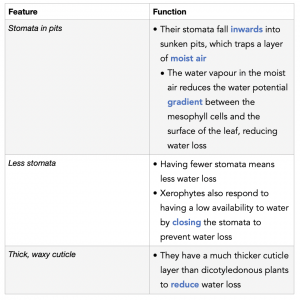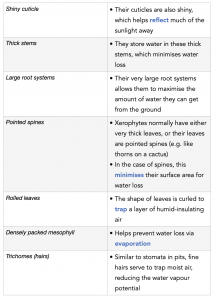Introduction to Xerophytes (A-level Biology)
Introduction to Xerophytes
Xerophytic Plants
- Xerophytic plants are adapted to living in hot, dry environments. Xerophytes live in very hot and dry conditions, so need to be adapted to minimise water loss. An example of xerophytes are cacti.
- Xerophytes need to minimise transpiration. Due to the heat of the environment, and low water vapour in the air, the risk for losing water through transpiration is very high in xerophytes.
- Xerophytes have developed several adaptations to survive:


Xerophytes are plants that have adapted to living in dry and arid environments. These plants have developed special structures and adaptations that allow them to survive in areas where water is scarce.
Xerophytes have several adaptations that help them survive in dry environments. These include:
Deep roots: Xerophytes have deep roots that can reach underground water sources.
Reduced leaves: Xerophytes often have small, reduced leaves that minimize water loss through transpiration.
Waxy or hairy surfaces: Some Xerophytes have waxy or hairy surfaces that reduce water loss by limiting the amount of air that comes into contact with the plant’s surface.
Storing water: Some Xerophytes store water in their stems, leaves, or roots to use during dry periods.
Adaptive leaf structures: Some Xerophytes have adaptive leaf structures, such as spines, that reduce water loss and help protect the plant from herbivores.
Xerophytes are found in a variety of dry and arid environments, including deserts, semi-deserts, and Mediterranean climates. They are also found in areas where water is scarce, such as rocky outcrops, dry river beds, and coastal dunes.
Some examples of Xerophytes include cacti, succulents, aloes, and agave plants. These plants are well adapted to dry environments and have evolved a range of strategies to survive in these conditions.
The study of Xerophytes is important for A-Level Biology students as it provides a fundamental understanding of the adaptations that plants have developed to survive in dry environments. Understanding the adaptations of Xerophytes can help students to understand how plants are able to survive in extreme environments, and this knowledge can be applied to other areas of biology, such as the study of plant physiology and ecology. The study of Xerophytes also provides students with an opportunity to develop their scientific observation skills, as they can observe and study the unique structures and adaptations of these plants in detail.
Xerophytes play an important role in the ecosystems in which they live. They help to stabilize the soil and provide habitat for a range of other species, such as birds, reptiles, and insects. Xerophytes are also an important source of food and water for many species, and they play a crucial role in maintaining the balance of these ecosystems.
Yes, Xerophytes have a range of commercial uses, including as ornamental plants, for food and medicine, and for the production of oils, dyes, and other products. Many Xerophytes are also used for landscaping and horticulture, as they are well adapted to dry conditions and can be grown in areas where water is scarce.
The study of Xerophytes can contribute to conservation efforts by providing a better understanding of the adaptations that plants have developed to survive in dry environments. This knowledge can be used to develop strategies for preserving these plants and their habitats, and to prevent the loss of these important species.






Still got a question? Leave a comment
Leave a comment